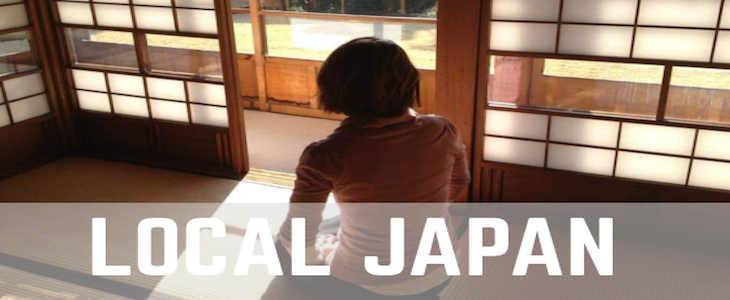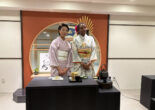
Local Japan : Matsudo City Welcome with a Bang
The morning I walked up my front street, bags in tow, to move into my cute vintage house I was confronted with a hoodlum’s welcome. In the shopping arcade, an old car, the headlights bashed out, filled with garbage and empty drink cans, with the message “Shine!” Go die, scrawled on the hood, was parked diagonal in the road. Welcome to trashy Matsudo City, I thought. I gritted my teeth, and thought, okay, I have seen worse in my hometown of Vancouver, Canada. I thought to myself, I can deal.
I didn’t know then that I didn’t have to. Within a week, local business owners, elderly ladies, workmen, came out in force with staves and stern looks, driving the bosozoku to the edge of our neighborhood. Bosozoku, meaning violent and noisy speed tribes, are a fading cultural phenomena in Japan’s urban areas. In their heyday of the 1970s and 1980s, the bosozoku, mostly teenage and 20 something delinquents, rode in convoy along major routes, annoying drivers and pedestrians, waving sticks and pipes, and disturbing neighborhoods at all hours. These days, their numbers are dwindling with the shrinking cohorts of young people each year. It also appears that, as teens’ disposable income diminishes, and police surveillance improves, young people are less able or willing to participate. A small band that confronted our neighborhood watch was easily pushed back to the highway at the edge of the Edo River. For a long time, we could hear them in the distance on their motorcycles late on Friday and Saturday nights, revving their engines through modified pipes for maximum noise.
Despite the rough welcome, the neighborhood was charming and the neighbors lovely. Most in my little lane of eight houses were elderly, and if you added up their ages I’m sure they came close to 1000 years collectively. That means they had seen it all. The post-war years, their children maturing and having their own children, and watching the city of Matsudo change around them. They were not in the least bit surprised to have a non-Japanese tenant move in next door. I loved greeting my nearest neighbor in the morning when he came out to mind his bonsai trees. Further up the lane, an elderly lady tended to a fig tree that overhung the street. She told me one day that when she was an elementary school student, her teacher had each child plant a tree. She had cared for it, pruning and feeding it, since then and had brought it with her when she moved into her marital house, over 40 years before. When it bore fruit each year, she shared with us the bounty. I found a recipe for figs, cheese and pasta, and we had a big feed in our lane.

Cooking a big dinner was easy because the house had an ample kitchen by Japanese standards. It also helps that we had access to fresh produce. Close the station on the Joban Line, the neighborhood is dense and urban, but as you move towards the Edo River, the houses fade away, and farm gardens and rice paddies are more frequent. In the front shopping street, once a week, I bought a bag of eggs from the grocer. Next to the register was a big container of nukazuke, rice bran pickles. For a few hundred yen, I got a bag of cucumber, eggplant and daikon radish. On weekends, I passed by the farm that provided the produce and eggs as I rode to the river.
Besides the occasional noise assault from the bosozoku, we had some other exciting times in our neighborhood which pulled everyone together. In September of 2015, the Kanto area had extremely heavy rainfall that continued for days. Parts of western Ibaraki Prefecture suffered catastrophic flooding and wide property damage. In Matsudo City, close to the river, the water level in the canals rose higher and higher, as our phones chimed frequently with warnings and evacuation orders for the low lying areas along the Edo River. As the water became ankle-deep in our lane, the neighbors and I got our tools ready to pull up the tatami mats from our first floor rooms. Neighborhood association captains went door to door offering to pull up and pile up the tatami and furniture with us. Fortunately, the fire department brought pumper trucks and got the water level down quickly, and our houses were no longer threatened. This first-hand experience of disaster preparation on the part of the neighborhood association was impressive. The whole community mobilized to prepare to protect property and get residents out if necessary.
The following January, again we were awed by the power of nature when snow blanketed our houses and streets. One morning, after a night on which snow piled up knee-deep, I received a message to tell me not to come in to work. Transportation in Matsudo City was at a standstill, and the streets were treacherous. In our lane, we dug out a path to each house and to the main road all morning. When I was done, I went for a walk to appreciate the quiet and sparkling white roofs and gardens, but I was pleasantly surprised to see families laughing and shoveling away. I joined in, helping to heave snow onto a makeshift sled and dumping it in the canal nearby. It was a lot of hard work to make a path, but eventually, many sled loads later, the street was clear. We all parted with smiles, and after that, when we met while on errands and shopping, we took time to chat.
Besides all the weather related challenges, the Matsudo City community came together to celebrate. The following summer, the neighborhood hosted the biennial dance festival in front of Mabashi Station just north of Matsudo City’s center. You may expect that a festival means yukata and taiko drums, and Japanese motifs in the gestures and decorations. But this festival is something different because it is a samba carnival. Brazil, the spiritual home of carnival, is home to the largest community of Japanese people outside of Japan, and the cultural and family ties endure in Matsudo. The samba festival at Asakusa draws dancers and crowds from all over greater Tokyo.


But our local festival, which goes on all weekend, brings lavishly costumed teams of samba dancers and musicians to our small front street. At Asakusa, spectators are urged to arrive early because the crowds are so dense, and staking out a spot from which you can see the procession requires some preparation. However, at Mabashi, there is plenty of space at the curb, and photographers get great shots of the dancers up close. It’s very intimate, no less spectacular than the bigger festival, and you can greet the dancers and drummers as they go by. Viewers become part of the festivities by singing and tagging along behind the parade. Unlike other typical events in Japan that start and end precisely on time, this one goes on and on after the finale, with the samba beat pumping into the early evening. The crowds mingle with the dancers and drummers, chatting, singing and cheering.
Besides this blowout party at our local station, Matsudo people express themselves through other arts. The first time I visited the city, I looked up to see a white tiger glowering back from the wall of a building. Underfoot are mosaic pavements along the shopping street. It seems everywhere you turn in Matsudo, there is street art.

Matsudo City bills itself as an “art city for living”. The city sponsors artists from all over the world to give talks, display their works, and teach art techniques in workshops for children and adults. The program results in permanent installations, murals and mosaics on the public architecture such as pedestrian tunnels and highway overpasses. It is worth taking an afternoon to cruise around the town looking at the artwork in this big open-air gallery.
The city’s mission is to celebrate the arts and the rich history of Matsudo represented by two evocative historic sites. On the hillside overlooking the Joban train line, is Tojo-tei. This villa was the home of one of the last heirs of the Tokugawa shogun dynasty. Tokugawa Akitake prepared to take on the role of shogun. The government sent him off to Europe on a diplomatic mission where he made great headway building ties with governments there. But while he was absent, the emperor system was restored, and he was no longer needed. Tojo-tei became his project, putting Matsudo on the map as a shogun’s hometown.

Not far away at the Edo River is another artifact of the shogun. At the riverbank, a single wooden ferry crosses from Yagiri on the Matsudo side to Shibamata on the Tokyo side. The ferry originated when farmers of the old capital, Edo, needed transport to the fields on the east bank at what is now Matsudo. The shogun subsidized the tiny ferries for a low price. As bridges were built to connect the two cities, the need for ferries diminished. The ferry at Yagiri is the last wooden human-powered ferry on the Edo River. It is memorialized in enka songs and novels.
The Edo River drew me back again and again, with intimate views and quiet soundscape of the riverside from the ferry, and the more exuberant summer celebration of fireworks. Matsudo City and Katsushika Ward on the Tokyo side have major fireworks festivals that light up the river in the summer. The levee is quite high, so there are great viewing spots. On some summer weekends there are dozens of fireworks displays scheduled from the Tone River at the border with Ibaraki Prefecture all the way to the Sumida River fireworks at Asakusa. One Saturday night, I stood on the river bank and counted eight different fireworks displays in all directions lighting up the night.
Matsudo City still draws me back even though I moved on to a different home. Sometimes, I consider moving back because it is not only very convenient to Tokyo, but a place with lots of cultural interest and a vibrant community.
Related Articles
Warning: Undefined array key "sfsi_threadsIcon_order" in /home/veremosglobal/tokyoroomfinder.com/public_html/blog/wp-content/plugins/ultimate-social-media-icons/libs/controllers/sfsi_frontpopUp.php on line 165
Warning: Undefined array key "sfsi_blueskyIcon_order" in /home/veremosglobal/tokyoroomfinder.com/public_html/blog/wp-content/plugins/ultimate-social-media-icons/libs/controllers/sfsi_frontpopUp.php on line 170
Warning: Undefined array key "sfsi_bluesky_display" in /home/veremosglobal/tokyoroomfinder.com/public_html/blog/wp-content/plugins/ultimate-social-media-icons/libs/controllers/sfsi_frontpopUp.php on line 266



